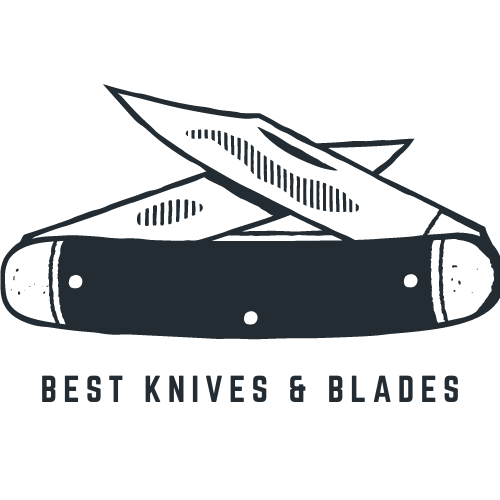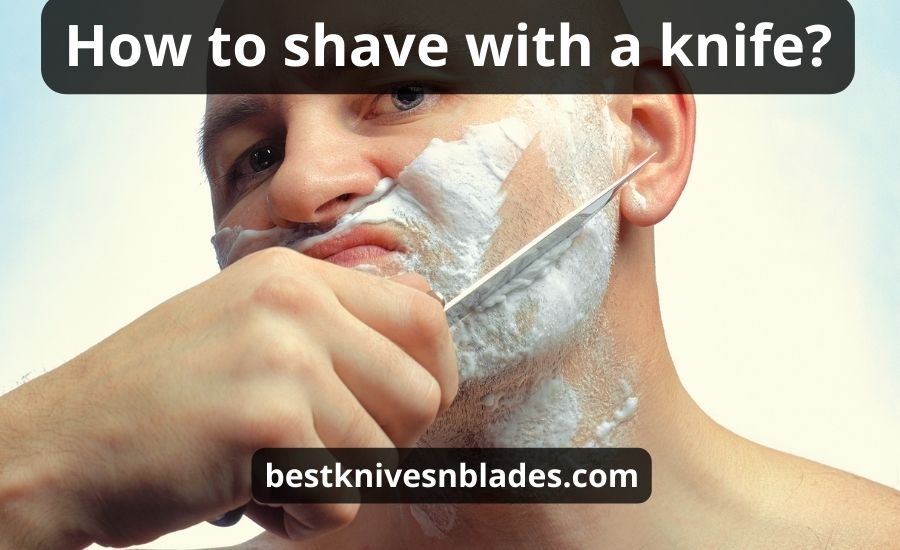How to shave with a knife? Shaving is an age-old grooming ritual that has evolved over the centuries.
And although we love our state-of-the-art blades, which make the shaving process so easy and safe, something is intriguing about the art of shaving with a knife.
Picture a time when our ancestors honed their blades to perfection, mastering the technique of achieving a clean, smooth shave with nothing more than a sharp edge.

So, if you’ve ever been curious about the age-old tradition or are bored of shaving with a razor blade, join us, and we’ll equip you with the knowledge and skills you need to master the art of shaving with a knife.
It’s a skill that harks back to a simpler time, and it might just be the closest shave you’ve ever experienced.
Everything you need
Shaving with a knife is a unique and rewarding experience, but it requires more precision and care than you need with a razor blade.
Before you begin, make sure you have all the necessary tools at your disposal:
- a sharp knife
- shaving cream
- a shaving brush
- a hot towel
- a mirror
Follow the steps we are outlining below and achieve a smooth shave.
Preparation
Hot shower. Start by taking a shower or placing a warm towel on your face to soften your facial hair or body hair and open up your pores.
This will make the shaving process smoother and reduce the chances of irritation.
Knife sharpening. Ensure that you keep the knife sharp.
Whether you’re using a straight razor or a pocket knife, a razor-sharp blade is essential for a perfect shave.
If you’re using a kitchen knife, make sure it’s extremely sharp.

Applying shaving cream
Use a high-quality cream and a shaving brush to apply a generous layer of cream to your face or the area you intend to shave (more than you would do with a razor blade).
The cream not only lubricates the skin but also helps to lift the hair for a smoother shave.
Technique
Hold your skin taut with your free hand. This helps to create a smooth, flat surface for the knife to glide across.
Hold the knife at a 30-degree angle to your skin.
This angle ensures that you cut the hair cleanly without irritating it.
Start shaving
Begin shaving in the direction of hair growth.
For most areas, this means shaving downward. Take short, controlled strokes, and avoid applying excessive pressure.
The technique is similar to the one you use shaving with a razor blade.
Be mindful of the contours of your face or body, adjusting the angle of the knife as needed to follow the curves.

Rinse and reapply
Periodically rinse the blade in hot water to remove shaved facial hair and cream. Reapply shaving cream as needed for a smooth glide.
Final pass and cleanup
For an even closer shave, you can make a final pass against the direction of hair growth. However, be extra cautious during this step to avoid razor burn or ingrown hairs.
Rinse and moisturize
After you’ve achieved your desired level of smoothness, rinse your face with cold water to close the pores. Pat your skin dry gently with a clean towel.
Apply a soothing, alcohol-free aftershave or moisturizer to hydrate and protect your skin.
Remember, shaving with a knife requires more practice to master, than you would need with a razor blade, so take your time and proceed with caution.
It’s essential to prioritize safety and avoid rushing through the process. With practice, you can achieve a clean shave that harks back to a bygone era.

Knives appropriate for shaving
When it comes to knives for shaving, the choice of the blade is crucial.
While various types of knives can be used for this purpose, it’s essential to select one that suits your preferences and comfort level.
Straight razor
This razor, also known as a cutthroat razor, is the quintessential choice for traditional shaving. It consists of a single, long blade that folds into a handle.
Straight razors provide excellent control and precision, making them a favorite among experienced shavers.

Pocket knife
If you’re looking for a more unconventional option, a pocket knife can be used for shaving with care.
Choose a pocket knife with a very sharp blade and a manageable size for better control.
The soft steel blade of such a knife makes it easier to keep sharp.
Even if it’s just a pocket knife, it can do the job relatively well.
Kitchen knife
Surprisingly, some individuals have successfully used an extremely sharp kitchen knife for shaving.
However, this approach requires extra caution and skill, as a sharp kitchen knife is not designed for grooming purposes.
Bowie knife
A bowie knife, with its distinctive large blades, can also be employed for shaving.
Ensure the blade of the bowie knife is sharpened to perfection and exercise extreme caution during use.
Swiss Army knives
Some Swiss Army knives come equipped with a straight-edge blade, making them a versatile option for grooming in a pinch.
Keep in mind that the smaller size of the blade may require additional time and care.

Pros and cons of using knives for shaving
Whether it’s a pocket knife, or a very sharp kitchen knife, using a knife for shaving offers a unique experience and comes with its own set of advantages and disadvantages.
Let’s explore the pros and cons of this unconventional shaving method.
Safety considerations
Shaving using a knife can be a rewarding and precise grooming method, but it also carries inherent risks due to the sharpness of the blade. To ensure a safe and enjoyable experience, it’s crucial to follow these safety considerations:
- Always ensure that the blade you’re using is extremely sharp. A dull blade can lead to more nicks and cuts as you’ll need to apply additional pressure.
- Regularly maintain and sharpen knives you will use for shaving. A well-maintained blade not only ensures a smoother shave but also reduces the risk of accidents.
- Avoid rushing through the shaving process. This way of shaving demands patience and precision. Hasty movements can result in cuts and irritation.
- Ensure proper preparation, including a hot shower or warm towel to soften hair and open pores. This reduces the chances of ingrown facial hair or body hair.
- Apply a high-quality shaving cream to protect your skin.
- Maintain taut skin with your free hand as you shave to avoid cuts.
- Avoid pressing too hard, as this can increase the risk of cuts and skin irritation.
- Maintain the correct shaving angle, typically around 30 degrees to your skin. Using the wrong angle can lead to nicks and discomfort.
- Periodically rinse the blade in hot water to remove shaved hair and shaving cream residue. This helps maintain the effectiveness of the blade.
- If you choose to make a final pass against the grain, do so with extreme caution to avoid razor burn.
- After shaving, use a soothing, alcohol-free aftershave or moisturizer to hydrate and protect your skin.
- If you’re using disposable blades or replaceable blades, dispose of them safely in a designated container or blade bank.
- If you’re new to knife shaving, consider seeking guidance from experienced shavers or even taking lessons. Proper technique is crucial for safety.

And finally…
The choice to shave with a knife, whether it’s a Swiss Army knife, pocket knife, or even a kitchen knife, comes with its own set of pros and cons.
The unparalleled closeness of the shave and potential cost savings are among the advantages, while the increased risk of cuts are challenges to be mindful of.
Safety is paramount when it comes to knife shaving.
Ensuring your knife sharpened, maintaining proper technique, and following essential safety precautions will help you enjoy the benefits of this grooming method while minimizing the risks even if you are using a pocket knife.
FAQ
Is it okay to shave with a knife?
If you don’t have access to a safety razor blade, or for another reason, shaving with a knife can be safe and effective with the right skills, sharp blade, and safety precautions. You can even employ a pocket knife for that purpose.
How do you shave with a shave knife?
Shave with a sharp knife using proper technique, pre-shave preparation, and safety precautions. Seek guidance if you’re new to knife shaving.
What angle should a knife be to shave?
Maintain a 30-degree angle to your skin (e.g. upper lip) when shaving with a knife for optimal results and safety.
Can I shave with a pocket knife?
Yes, you can shave with a pocket knife, but exercise caution and use proper technique to minimize risks as a pocket knife is not an easy shaving tool.
Can you shave with a knife? (Yes, here’s how)
1. Use a sharp pocket knife or another type of knife.
2. Prepare your skin with hot water.
3. Apply shaving cream.
4. Maintain a 30-degree angle to your skin.
5. Take your time and follow safety precautions while shaving with a pocket knife.
6. Rinse and moisturize after shaving with a pocket knife.
Is laser hair removal effective?
Yes, it’s effective as it will destroy hair follicles thus preventing facial or body hair regrowth.

